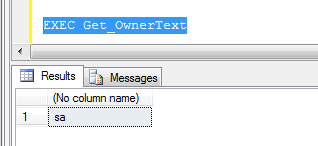It’s very common to come across user-defined modules that are written to execute as the owner. Not to be confused with the EXECUTE AS, the EXECUTE AS Clause will change the account context that is used to validate if the procedure, function etc… can be executed under the credentials. This can be useful when you want to control permissions to a certain extent. However, it can also be problematic when certain ownership changes have been made.
Troubleshooting Failures
One of the most common failures that you will run into when the EXECUTE AS OWNER is used, is a failure to execute the module with access denied error messages. Now, at first this can be confusing but the error does point to the area that is the culprit. This error can even be shown when a user is in the sysadmnin server role and has complete control of the machine. For example, a SQL Express installation may be used for mobile applications and later synchronized back to a repository. Even with the sysadmin server role membership, a call to say, a procedure using the EXECUTE AS OWNER, can fail based on the ownership hierarchy that is in place.
Database Ownership
First, review the ownership of a database. If a database is created under sa ownership, the ownership flows to all the objects under it unless specifically changed. This would allow the EXECUTE AS OWNER to be used freely and execute everything that falls in the confines of the database ownership and sa context. If the owner is change, possibly during a restore or some other reasoning, the objects that fall under it will fail with the EXECUTE AS OWNER are essentially broken.
Let’s look at an example. Create the following database
CREATE DATABASE [OwnerTest] ON PRIMARY
( NAME = N'OwnerTest', FILENAME = N'C:OwnerTest.mdf' , SIZE = 409600KB , FILEGROWTH = 2%)
LOG ON
( NAME = N'OwnerTest_log', FILENAME = N'C:OwnerTest_log.ldf' , SIZE = 52224KB , FILEGROWTH = 2%)
GO
ALTER DATABASE [OwnerTest] SET RECOVERY SIMPLE
GO
USE OwnerTest
GO
EXEC sp_changedbowner sa
GO
Notice we changed the owner to sa. This was to set the database up for the example. The owner, by default, would be the account executing the statement above otherwise.
Create a simple procedure to test
CREATE PROCEDURE Get_OwnerText
WITH EXECUTE AS OWNER
AS
SELECT SUSER_SNAME()
GO
Run the procedure and review the results
This is all expected behavior.
Create another database on a different instance but leave the owner as a user that does not have rights on the first SQL Server instance to any objects in the database itself or a valid login.
CREATE DATABASE [OwnerTest2] ON PRIMARY
( NAME = N'OwnerTest2', FILENAME = N'C:OwnerTest2.mdf' , SIZE = 409600KB , FILEGROWTH = 2%)
LOG ON
( NAME = N'OwnerTest2_log', FILENAME = N'C:OwnerTest2_log.ldf' , SIZE = 52224KB , FILEGROWTH = 2%)
GO
ALTER DATABASE [OwnerTest2] SET RECOVERY SIMPLE
GO
Run a simple backup of the database created on the second instance
BACKUP DATABASE [OwnerTest2] TO DISK = N'C:OwnerTest2.bak' WITH NOFORMAT, NOINIT, NAME = N'OwnerTest2-Full Database Backup', SKIP, NOREWIND, NOUNLOAD, STATS = 10
GO
Results
58 percent processed.
77 percent processed.
81 percent processed.
92 percent processed.
Processed 216 pages for database ‘OwnerTest2’, file ‘OwnerTest2’ on file 1.
100 percent processed.
Processed 2 pages for database ‘OwnerTest2’, file ‘OwnerTest2_log’ on file 1.
BACKUP DATABASE successfully processed 218 pages in 0.227 seconds (7.472 MB/sec).
Use the backup from the second instance housing database OwnerTest2 and restore it, replacing OwnerTest on the first instance.
USE Master
GO
RESTORE DATABASE [OwnerTest] FROM DISK = N'C:OwnerTest2.bak' WITH FILE = 1,
MOVE N'OwnerTest2' TO N'C:OwnerTest.mdf',
MOVE N'OwnerTest2_log' TO N'C:OwnerTest_log.ldf',
NOUNLOAD, REPLACE, STATS = 10
GO
Results
58 percent processed.
100 percent processed.
Processed 216 pages for database ‘OwnerTest’, file ‘OwnerTest2’ on file 1.
Processed 2 pages for database ‘OwnerTest’, file ‘OwnerTest2_log’ on file 1.
RESTORE DATABASE successfully processed 218 pages in 0.547 seconds (3.101 MB/sec).
Make sure that a query window is open with the context as a user that is in the sysadmin server role or that is an owner of the database, OwnerTest. This is simply to show the high level access that the account has, still will not execute the procedure successfully. Execute the procedure that was created earlier, Get_OwnerTest.
Msg 15517, Level 16, State 1, Procedure Get_OwnerText, Line 0
Cannot execute as the database principal because the principal "dbo" does not exist, this type of principal cannot be impersonated, or you do not have permission.
The message comes up that directs us to the user that is executing the procedure does not have rights to do so. This is due to the database ownership mentioned before. At this point, the owner of the database is a login that does not exist on the server nor has any access or capable means of being authenticated. Since this occurs, the procedure fails because the account is either in an orphaned state or simply, the account context does not have access. The more interesting aspect of this is, the owner will show as the previous over of the database. This essentially means a normal troubleshooting step of validating the owner may tell someone that the ownership is fine. However, it is not. You can review this by using the SP_HELPDB system procedure.
Run the last change ownership procedure to move the ownership back to sa or another account that has full rights.
EXEC sp_changedbowner sa
Go
Run the procedure again to validate it is successful.
Conclusion
Using the EXECUTE AS Clause does have value and can allow the ability for modules to be executed with limited needs put into security. However, it isn't as secure as creating a solid security setup and schema setup and controlling each object execution under the executing account. It is also prone to some errors when the chain of ownership has been broken.










